

Your first experience with any router
table that is not equipped with some form of dust collection
will fast convince you that a change is in order. Dust, as it
is swirling around in the table gets sucked into the router,
which isn't healthy for the router. Not only that, but it forces
you to clean the inside on a regular basis - so why put up with
it? You can add a simple pipe system, allowing your vacuum to
do the job for you. I used 1 1/2" PVC pipe that adapts perfectly
with My
Spiffy Shop Vac and my central
dust collection system. While your face frame is curing in
the clamps, let's install the piping for the dust collection.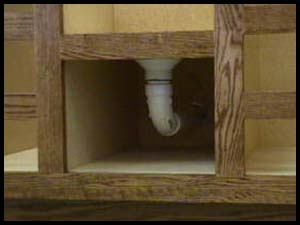
The plumbing is 1 1/2" schedule 40 PVC.
![]() 1 - sanitary 4-way tee
1 - sanitary 4-way tee
![]() 2 - 1 1/2" sweep 90's
2 - 1 1/2" sweep 90's
![]() 1 - 3" to 1 1/2" adapter
1 - 3" to 1 1/2" adapter
![]() 1 - 1 1/2" slip plug
1 - 1 1/2" slip plug
![]() 5' - 1 1/2" pipe
5' - 1 1/2" pipe
Hopefully, your hole has been already
drilled in the intermediate shelf. If not, then drill a hole
to accommodate the 3" adapter. The hole should only be big
enough to allow the adapter to just slide through. Next, cut
a short piece of pipe so that you're able to connect one of the
sweeps to the adapter then put these pieces together (do not
glue them at this time). Measure the distance from the bottom
to the center of the sweep then transfer this measurement to
the back of the carcass and cut that hole. Be sure it is only
large enough so that the bell end of the remaining sweep can
pass through.
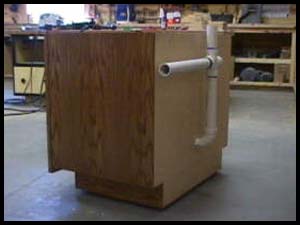
The next step is to provide piping for the suction from the fence and finally to the vacuum. In the picture (left), the sanitary 4-way tee has to be used because the turns are curved in the direction of the suction out, making it easy for debris to make the curves without getting lodged in the tee. The pipe sticking up from the tee allows a connection from the fence to help in the dust collection process.
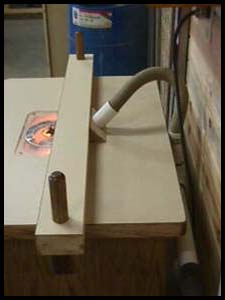 It would do no good to
have debris remaining near the fence when it's so easy to provide
for dust collection at that location too. The tee in the system
allows you to extend another piece of pipe up near the tabletop
so that a hose can connect the fence into the system.
It would do no good to
have debris remaining near the fence when it's so easy to provide
for dust collection at that location too. The tee in the system
allows you to extend another piece of pipe up near the tabletop
so that a hose can connect the fence into the system.
The system should project 1 1/2" behind the back of the carcass so that the overhang of the tabletop will not interfere with the dust collection system. The piece above the tee should be allowed to extend above the tabletop - for right now, cut it long. When all the parts are cut, assemble them dry to be sure they all fit. At this point, screw through the sides of the adapter into the shelf so that it remains in position.
By now, the face frame should be ready to remove from the clamps. Sand and finish it to your satisfaction. The face frame's dimensions are such that 3/8" will overhang the carcass on each side. The purpose of this is to allow for a 1/4" panel to be applied to the particleboard sides thereby leaving the face frame 1/8" proud of the side panels. I used 1/4" Red Oak plywood for these panels and for the toe-kick covering. Rip these pieces to 4 5/8" and long enough to cover the three sides of the toe-kick and cut the panels to fit the sides then sand and finish. Once the finish has dried apply the face frame, side panels and toe-kick covers to the carcass. I used brads and glue here.
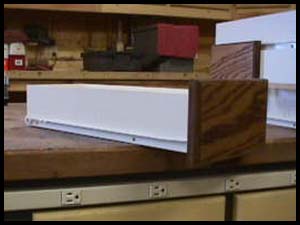 The type of drawer system
you use is entirely up to you. I used drawer slides from Blum
but since there are so many manufacturers of these things it's
really difficult to address making drawers. I made mine with
simple butt joints, stapled together. They are 18" long
and 1 1/16" narrower than the drawer opening in the face
frame, which is in this case, 6 1/16" wide and 1" shorter
in height. All the stock was ripped at the table saw using a
melamine blade and cut to length at the miter saw. The bottoms
are stapled on the assembled drawer parts. I used melamine but
particleboard or something fancier would work just as well.
The type of drawer system
you use is entirely up to you. I used drawer slides from Blum
but since there are so many manufacturers of these things it's
really difficult to address making drawers. I made mine with
simple butt joints, stapled together. They are 18" long
and 1 1/16" narrower than the drawer opening in the face
frame, which is in this case, 6 1/16" wide and 1" shorter
in height. All the stock was ripped at the table saw using a
melamine blade and cut to length at the miter saw. The bottoms
are stapled on the assembled drawer parts. I used melamine but
particleboard or something fancier would work just as well.
The drawer fronts (left) and the lower
door of the plumbing compartment were made from Red Oak MDF while
the router compartment door was made from 4/4 Red Oak and the
joints mitered. A rabbet was cut on the inside edges to receive
the Plexiglas panel. I then drilled 3 - 3/4" holes near
the top of the Plexiglas panel to allow make-up air to enter
the router compartment. These holes are important because air
coming in from the top assists in drawing dust and debris down
past the router and into the vacuum port. 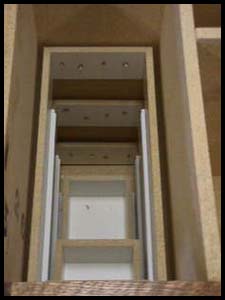
The drawers are supported by a unique method. The drawer assembly supports (left) will work in ANY cabinet and are surprisingly stout despite the cheesy appearance. The sides are 3" wide and 2 1/2" shorter than the distance from the inside back of the carcass to the front of the face frame. The rear piece is always the same length as the actual drawer opening in the face frame. You first attach the cabinet glides with screws then staple together the final assembly. I made a jig that works universally on every length of drawer slide.
The drawer assembly supports are best installed by working from the bottom up. You first screw the ears of the slide to the inside edges of the face frame. Then, after the drawer is in the glides, reach into the cabinet and support the rear with one hand while the other hand keeps the drawer front flat and tight to the face frame. Next, (this is where a shop helper comes in handy) staple (or nail or whatever) through the back of the carcass into the rear section of the assembly (see photo, left), the staples (or whatever you use) should be long enough to poke through. Two staples, one at each end is placed then the drawer is checked for unhindered operation or for improper drawer front alignment. If so, the rear can be shifted left/right or up/down then the final "holding" staples can be placed.